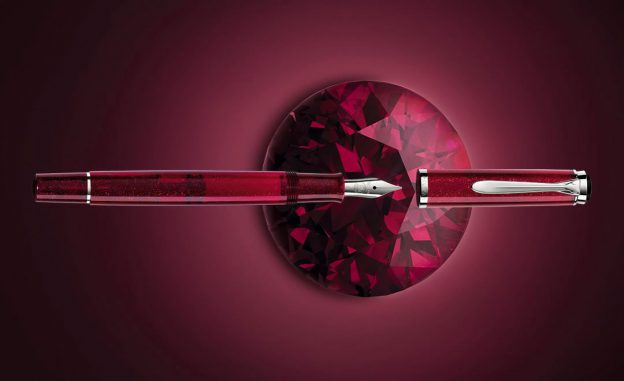The word Edelstein, in german, means ‘gemstone’. This comes as no surprise scrolling through the list of colors available in Edelstein ink, each one being named after a different gemstone. This years’ Edelstein Ink of the Year is the Pelikan Star Ruby. It is preceded by Olivine (2018), Smoky Quartz (2017), and Aquamarine (2016), to name a few. While its name, Star Ruby, evokes thoughts of the color red, this years’ ink is more of a burgundy-pink. In tandem with this new ink, Pelikan has once again announced matching writing instruments, in particular, the Pelikan Star Ruby fountain pen and a ballpoint pen.
The namesake of this years’ color comes from the Star Ruby gemstone, a variety of ruby that exhibits a six-rayed star across the top of the gem. This star has a sparkling effect when moved. This particular phenomenon is also visible in the new Pelikan Star Ruby writing instruments. Both the fountain and ballpoint pen come in the burgundy-pink color but are also made with a special crystal effect that makes the pens glitter.
Pelikan Star Ruby Fountain Pen
Both pens are offered with silver trim and the classic Pelikan beak clip. The fountain pen comes with a differential piston mechanism, while the ballpoint pen has a push mechanism.
History of Pelikan
The company was first started by the chemist, Carl Hornemann in 1832, who founded his own color and ink factory. However, the date on the very first price list was in 1838 and so all company anniversaries are based on this instead. As it goes, perhaps the most fateful year for the company was 1863 as that was the year that Gunter Wanger was hired. He worked there as a chemist and a plant manager until 1871 when he took over the company. Until the guidance of Wagner, Pelikan started down the path of becoming the global brand that it is today.
Wagner is credited with one of the most iconic aspects of the Pelikan brand—its trademark. One of the first German trademarks ever, Wagner adapted the Pelikan symbol from the pelican that was present upon his family’s crest. He registered the company’s trademark in 1878.
Many of the products that Pelikan is known for were not available until after World War I. Fountain pens proved themselves difficult throughout the war, presenting problems within the need to carry ink and an inability to keep the writer’s hands clean of ink. Fueled by these shortcomings Theodor Kovacs, a Hungarian engineer, invented the piston filling mechanism. In 1927 Kovacs sold the patents for his invention to Wagner, who later re-patented in 1929, under his own name. In that same year, Pelikan launched its first fountain pen with the differential piston mechanism, which revolutionized peoples’ ability to use a fountain pen.
While Pelikan got its start as a company selling and developing colored inks, the Edelstein line of inks was not introduced until 2010, eighty-three years after the brand first ventured into the foray of fountain pens and other writing instruments. The Pelikan brand cites the Edelstein line superiority being credited to a “special ingredient”, which provides the inks with, “A pleasantly smooth writing comfort”.
Pen Carrying Cases
Best Pen Ink & Refills
Buy Fountain Pens
Pen Brands
Krishna
Colorverse
KWZ Fountain Pen Ink





